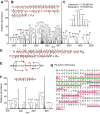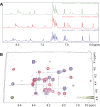New techniques, applications and perspectives in neuropeptide research
- PMID: 29439063
- PMCID: PMC5818036
- DOI: 10.1242/jeb.151167
New techniques, applications and perspectives in neuropeptide research
Abstract
Neuropeptides are one of the most diverse classes of signaling molecules and have attracted great interest over the years owing to their roles in regulation of a wide range of physiological processes. However, there are unique challenges associated with neuropeptide studies stemming from the highly variable molecular sizes of the peptides, low in vivo concentrations, high degree of structural diversity and large number of isoforms. As a result, much effort has been focused on developing new techniques for studying neuropeptides, as well as novel applications directed towards learning more about these endogenous peptides. The areas of importance for neuropeptide studies include structure, localization within tissues, interaction with their receptors, including ion channels, and physiological function. Here, we discuss these aspects and the associated techniques, focusing on technologies that have demonstrated potential in advancing the field in recent years. Most identification and structural information has been gained by mass spectrometry, either alone or with confirmations from other techniques, such as nuclear magnetic resonance spectroscopy and other spectroscopic tools. While mass spectrometry and bioinformatic tools have proven to be the most powerful for large-scale analyses, they still rely heavily on complementary methods for confirmation. Localization within tissues, for example, can be probed by mass spectrometry imaging, immunohistochemistry and radioimmunoassays. Functional information has been gained primarily from behavioral studies coupled with tissue-specific assays, electrophysiology, mass spectrometry and optogenetic tools. Concerning the receptors for neuropeptides, the discovery of ion channels that are directly gated by neuropeptides opens up the possibility of developing a new generation of tools for neuroscience, which could be used to monitor neuropeptide release or to specifically change the membrane potential of neurons. It is expected that future neuropeptide research will involve the integration of complementary bioanalytical technologies and functional assays.
Keywords: Electrophysiology; FaNaC/HyNaC; Immunochemistry; Mass spectrometry; Neuropeptides; Peptide-gated ion channel.
© 2018. Published by The Company of Biologists Ltd.
Conflict of interest statement
Competing interestsThe authors declare no competing or financial interests.
Figures






References
-
- Abels M., Riva M., Bennet H., Ahlqvist E., Dyachok O., Nagaraj V., Shcherbina L., Fred R. G., Poon W., Sorhede-Winzell M. et al. (2016). CART is overexpressed in human type 2 diabetic islets and inhibits glucagon secretion and increases insulin secretion. Diabetologia 59, 1928-1937. 10.1007/s00125-016-4020-6 - DOI - PubMed
-
- Aguilar M. B., Zugasti-Cruz A., Falcon A., Batista C. V., Olivera B. M. and de la Cotera E. P. (2013). A novel arrangement of Cys residues in a paralytic peptide of Conus cancellatus (jr. syn.: Conus austini), a worm-hunting snail from the Gulf of Mexico. Peptides 41, 38-44. 10.1016/j.peptides.2013.02.016 - DOI - PMC - PubMed
-
- Altun Z. F., Herndon L. A., Wolkow C. A., Crocker C., Lints R. and Hall D. H. (eds) (2002-2018). WormAtlas. http://www.wormatlas.org.
Publication types
MeSH terms
Substances
Grants and funding
- T32 HL007936/HL/NHLBI NIH HHS/United States
- BB/M010392/1/BB_/Biotechnology and Biological Sciences Research Council/United Kingdom
- R01 NS029436/NS/NINDS NIH HHS/United States
- BB/H019472/1/BB_/Biotechnology and Biological Sciences Research Council/United Kingdom
- R01 DK071801/DK/NIDDK NIH HHS/United States
LinkOut - more resources
Full Text Sources
Other Literature Sources
Research Materials

